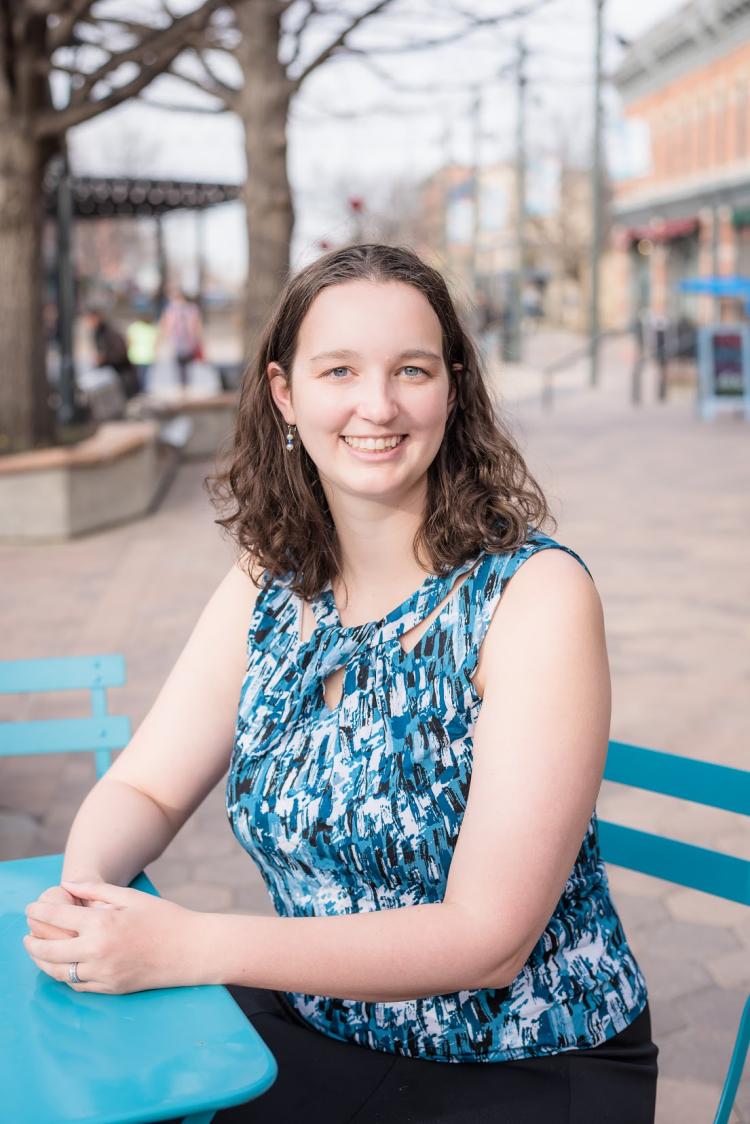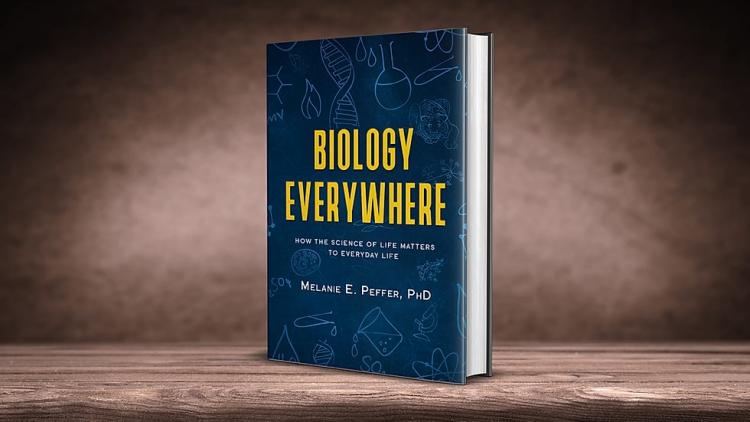Researcher aims to make biology more accessible
Newly published book, Biology Everywhere, is the product of CU Boulder biologist and learning scientist Melanie Peffer’s passion for good teaching and science literacy
Melanie Peffer doesn’t shy away from talking about science, particularly biology, with the general public. She claims that biology is everywhere, and people enjoy the subject more if they can relate to it.
Peffer, a research associate in the Department of Molecular, Cellular and Developmental Biology at the University of Colorado Boulder, has translated this passion into a new book, Biology Everywhere: How the Science of Life Matters to Everyday Life.

Melanie Peffer
Peffer, who holds a PhD in molecular biology from the University of Pittsburgh and completed a post-doctoral fellowship in learning sciences at Georgia State University, focuses her research on how people learn, understand and enjoy biology.
Recently, she answered five questions about her book and how people learn and understand science. The questions and her responses follow:
Question: In your essay in the American Biology Teacher, you mention students who say they’re not good at science or “have learned to hate” it. When and how did you develop a love of science generally and biology in particular?
Answer: My dad is an engineer, and he’s fostered a love and appreciation for science as long as I can remember. As I mention in my book, it was his tendency to explain scientific phenomena occurring in my immediate environment while growing up that was one of the inspirations for writing Biology Everywhere.
When science concepts were presented through the lens of what was happening in my immediate environment, they were more accessible and relatable. This led to developing beliefs that science is accessible and relevant to my daily life, which made engaging with the content throughout school easier.
My interest in biology was cultivated by excellent biology teachers in middle and high school, culminating in taking advanced placement biology my senior year of high school, then going on to declare a biology major in college.
Q: The National Academies and others have warned that the United States is falling behind in STEM teaching and research and that this trend will adversely affect the U.S. economy and health of its people. Do you share those concerns, and, if so, how does good teaching at the college level help address that concern?
A: I do share these concerns. I would also add that good science teaching is important across the educational spectrum, from preschool up through informal education to the general public, not just at the college level.
When specifically thinking about college level teaching, the vast majority of students are not majoring in STEM fields. If these students have poor attitudes or misconceptions about science (which research suggests is common), the science classes required for graduation are a last chance for science educators to foster more positive attitudes and conceptions about how science really works in the real world.
At the end of the day, it’s confidence to engage in these issues that is going to encourage students to engage with scientific issues long after the leave the classroom. Therefore, it is very important to U.S. economy and the health of its people for everyone to have the confidence and skill set to engage with the big science issues we are facing as a society.
Q: You discuss the lack of a scientific method in the beginning of your book; to what extent do you think the general public understands science, and why should the public understand it better?
A: Ah, the scientific method. We hear about it from elementary school through university teaching. The problem is, there isn’t a universal scientific method. This adherence to a universal scientific method has a negative impact on how the general public understands science and overall science literacy.
For example, it promotes the idea that if you follow a scientific method, you generate facts (and that you’ll always get an answer). However, science doesn’t actually work that way.
What we know is subject to revision in light of new evidence. This was most famously illustrated with the rejection of the geocentric model (the sun revolves around the earth) for the heliocentric model (the earth revolves around the sun). If you go outside, you see the sun move through the sky over the course of the day. However, with a telescope (which allows you to collect new/different evidence) it demonstrates that the reverse is true.
Not all scientific methods are the same, either. For example, scientific methodology can be inductive (theory building) or deductive (theory testing). Not all science methodologies need a control group (something that tends to be emphasized strongly in science fair projects). Planetary science and paleontology are both examples of disciplines where a control group isn’t necessarily warranted.

Melanie Peffer's new book "Biology Everywhere".
The bigger picture with misunderstanding of how science actually works to generate new information is that it gives the wrong idea about what science is and how it works. Thinking that science is all about generating facts and that science learning is about memorizing facts gives the impression that science is boring, straightforward, and not necessarily relevant.
With that view, on top of cultural views of scientists in a negative light (how many movies or books can you name where a scientist is the “bad guy” versus the “good guy”?) is it terribly surprising that many balk at engaging with science?
Authentic science is exciting, messy, iterative and creative. There isn’t necessarily a final answer, and what we know is continually evolving in light of new evidence. One of the functions of science is to help society, for example by developing solutions to problems (like understanding how people get cancer so that it can be prevented and/or treated better).
Viewing science both from an authentic viewpoint and through the lens of our daily experience makes it more accessible and engaging, empowering people to engage with scientific issues.
Q: Your book describes art as foundational to biology and discusses the “physiology of music.” Can you elaborate on those ideas briefly?
A: We are inundated with messages about STEM (science, technology, engineering and math). STEM schools, STEM toys, STEM camps, STEM careers etc. However, some are starting to move towards STEAM—adding an A for the arts.
It is very important to recognize how integrated the sciences are with fine arts. Art is foundational to biology, because the first biologists (or naturalists) needed to be able to draw organisms in the wild quickly and accurately to be able to communicate their findings to other scientists. There were no cameras—so, everything had to be drawn.
The father of neuroscience, Santiago Ramon y Cajal, hand drew images of neurons as he looked under a microscope. His images are still included in neuroscience textbooks today as well as art exhibitions. Even with the advent of easily accessible and quality digital photography, biological illustration continues to be a relevant and necessary part of the biological enterprise, for research, education and science communication purposes.
On the converse, biological sciences can tell us more about our experience with the arts. Feeling “chills” while listening to music is linked to release of dopamine (a neurotransmitter involved in how we feel pleasure). Anyone who has ever made music as part of a group can describe the feeling of connection with the other musicians.
Viewing science both from an authentic viewpoint and through the lens of our daily experience makes it more accessible and engaging, empowering people to engage with scientific issues."
There is more to it, though—people who sing together often will synchronize their heart rates. So, the integration of biology with the arts is seen both through the practice of biological research, importance for biology education, and for understanding our experience with music.
Q: Almost a century after the Scopes trial, evolution can evoke criticism, sometimes reflecting religious views; to what extent does this make it harder to teach biology?
A: Students enter classrooms with prior knowledge and beliefs—and those beliefs can include religious beliefs and beliefs that it is necessary to choose between dearly held religious beliefs and engaging with biology content, particularly around evolution.
Even if a student isn’t sure there is a personal conflict, the prior knowledge of the existence of any conflict between the two makes it more difficult to teach biology. Conflict, even perceived conflict, or fears about being persecuted for belief, makes people uncomfortable—and being uncomfortable is not conducive to learning.
On the converse, someone from a biology background may not enter into any religious setting for the same reason. Since religious organizations are often cornerstones of their community and are involved in outreach that benefits the community, the perceived conflict hurts our communities as well.
There is a wealth of information from both biological and religious scholars that suggests that the conflict between the two either does not exist or isn’t as severe as the media may lead us to believe it to be.
My experience teaching biology topics, including evolution, in religious settings suggests that presenting the biology of evolution in a respectful, open-minded manner leads to minimization of perceived conflict and increased acceptance of biological evolution. There is also research suggesting that talking about religious beliefs in biology classrooms can also help eliminate the conception that there is a conflict and facilitate biology education.
Bottom line, presenting the two in conflict makes it harder to teach biology and for members of society to engage in their communities via religious settings. Respectful discussions and reconciling viewpoints rather than promoting the presence of conflict facilitates good biology education and community engagement via religious settings.
The book is available at the Boulder Bookstore.

